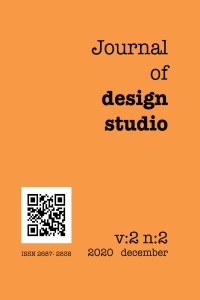Abstract
References
- Buchanan R., Doordan D., Margolin V.(2010), The Designed World:Images, Objects, Environments’, Hirst J, ‘Values in Design: ‘Existenzminimum, Maximum Quality and Optimal Balance, Berg, Oxford, NewYork, pg.306
- Cansever T. (2005), Mimar Sinan, Albaraka Türk Yayınları: 24, Kültür Kitapları: 2, ISBN:975-00582-0-8 (pages 267-273)
- Ching, F. (1996); Architecture: Form, Space and Order, John Wiley and Sons.
- Morris, C.W., (1939), Esthetics and the Theory of Signs, Journal of Unified Science , VIII p.131
- Morris, C.W., (1948), The Open Self , New York, p.55.
- Morris C.W. (1946), Signs, Languages and Behavior, New York, p.195.
- Jencks, C., (2000), Iconic Building, Rizzoli International Publications.
- Inns, T., (2007). Designing for the 21th Century-Interdisciplinary Question and Insights, ‘Spatial Imagination in Design, Gower Publishing, England
- Kaymakcan, M., (2006).‘The Basic Design Elements and Principles Education and Applications at Graduate Degree Art Education’, Master’s Thesis, Dokuz Eylul University, Education Sciences Instıtute,Fine Arts Education Department.
- Necipoğlu, G. (2005). The Age of Sinan Architectural Culture in the Ottoman Empire, Reaktion Books. (Sinan: Architect of Ages’ (the Republic of Turkey, Ministry of Culture),Text by: Metin Sözen, Photographed by Sami Güner, Coordinator Mehmet Özel, (pages 218-225)
- http://goldengate.org/exhibits/exhibitarea1c.php
- http://www.zaha-hadid.com/design/zaragoza-bridge-pavilion/
- http://www.fosterandpartners.com
- https://kantaratlas.blogspot.com/2014/12/buyukcekmece-bridge.html
- https://tr.wikipedia.org/wiki/Ponte_Vecchio
- https://en.wikiarquitectura.com/building/henderson-wave-bridge/
- https://en.wikipedia.org/wiki/Tower_Bridge
- https://www.ice.org.uk/what-is-civil-engineering/what-do-civil-engineers-do/sydney-harbour-bridge
- https://en.wikipedia.org/wiki/Golden_Gate_Bridge
- http://www.highestbridges.com/wiki/index.php%3Ftitle%3DMillau_Viadut
- https://en.wikipedia.org/wiki/Python_Bridge
- https://www.archdaily.com/185400/helix-bridge-cox-architecture-with-architect
- https://en.wikipedia.org/wiki/Hangzhou_Bay_Bridge
- https://www.dezeen.com/2008/06/16/zaragoza-bridge-pavilion-by-zaha-hadid/
- https://structurae.net/en/structures/borough-high-street-bridge
- https://structurae.net/en/structures/clyde-arc
- https://structurae.net/en/structures/media-city-footbridge
- https://www.archdaily.com/186214/kurilpa-bridge-cox-rayner-architects-with-arup
Abstract
This paper investigates bridges from ‘landmark of cities’ point of view under aesthetics theme. In fact, bridges gave many samples at history with high aesthetic qualities; constructed with diverse materials and vernacular traditional construction methods of the region and era they had been built. Bridges, however, known as engineering products, today it is expected from them to accommodate high aesthetic qualities as being perceptual productions of their environment. It is this ‘construction and aesthetics’ combination that makes them landmarks, which will be demonstrated in the paper by selected cases include both high structural and aesthetical qualities, transforms them to landmarks and icons of their city. On the other hand, by the development of new materials and construction styles, aesthetic consideration come forward by productions of sculptural steel construction bridges in cities. Basically paper consists of two parts, which first one is literature review that introduces aesthetic values in design, landmark features, classifications of iconic concept and 2nd part includes general mapping on bridges from past to present with different functional and constructional styles. In the article, aesthetics in design and landmark concept have been introduced strongly in order to understand the meaning of ‘icon’. Thus especially the design content of Enzio Manzini have been introduced in the article with his work ’21.th Century Values of Design’ which he explains the importance of aesthetics in design. In addition, at this part, design elements as an architectural language formed by ‘point, line, plane’ and visual elements such as; ‘shape, form, color and texture’ have been introduced. In order to continue, design principles such as rhythm, balance, emphasis, scale & proportion, hierarchy have been introduced in the study to reach landmark concept. At second part approximately fifteen unique bridge design and construction have been investigated from all around world such as; Florence, Singapore, London, Sydney, San Francisco, France, Amsterdam, China, Australia and Turkey. All of these selected bridges accommodate iconic features uniquely and differently from each other which transform them to a landmark of their city or environment. The uniqueness of the bridges depends on superiority of some features such as; the length, the height, type, function, construction, material, form, referring the construction system design such as; helix, space frame, steel tensegrity, cable stayed steel swing bridge, single arch and hangers, pods steel high tech materials, steel, pylons and abutments, suspension bridge, steel through arch bridge, wave form made up of seven undulating curved steel, stone build, a three stage pointed arched stone bridge. As indicated, all construction systems are unique and in addition they show highly aesthetic criteria. Thus, when a unique structure meets with technology and/or high aesthetic qualities such as design principles and color, the structure of a building becomes an icon for its city. Then, at 3rd part, four iconic bridge cases have been investigated through their aesthetic and landmark values. At the end, important keys will be collected for aesthetically designed future bridge constructions. To sum up, in the article, it is aimed to reveal landmark concept in the cities over bridge cases which are very aesthetical and flexible structures by their forms, construction styles, materials and functional diversities.
Keywords
References
- Buchanan R., Doordan D., Margolin V.(2010), The Designed World:Images, Objects, Environments’, Hirst J, ‘Values in Design: ‘Existenzminimum, Maximum Quality and Optimal Balance, Berg, Oxford, NewYork, pg.306
- Cansever T. (2005), Mimar Sinan, Albaraka Türk Yayınları: 24, Kültür Kitapları: 2, ISBN:975-00582-0-8 (pages 267-273)
- Ching, F. (1996); Architecture: Form, Space and Order, John Wiley and Sons.
- Morris, C.W., (1939), Esthetics and the Theory of Signs, Journal of Unified Science , VIII p.131
- Morris, C.W., (1948), The Open Self , New York, p.55.
- Morris C.W. (1946), Signs, Languages and Behavior, New York, p.195.
- Jencks, C., (2000), Iconic Building, Rizzoli International Publications.
- Inns, T., (2007). Designing for the 21th Century-Interdisciplinary Question and Insights, ‘Spatial Imagination in Design, Gower Publishing, England
- Kaymakcan, M., (2006).‘The Basic Design Elements and Principles Education and Applications at Graduate Degree Art Education’, Master’s Thesis, Dokuz Eylul University, Education Sciences Instıtute,Fine Arts Education Department.
- Necipoğlu, G. (2005). The Age of Sinan Architectural Culture in the Ottoman Empire, Reaktion Books. (Sinan: Architect of Ages’ (the Republic of Turkey, Ministry of Culture),Text by: Metin Sözen, Photographed by Sami Güner, Coordinator Mehmet Özel, (pages 218-225)
- http://goldengate.org/exhibits/exhibitarea1c.php
- http://www.zaha-hadid.com/design/zaragoza-bridge-pavilion/
- http://www.fosterandpartners.com
- https://kantaratlas.blogspot.com/2014/12/buyukcekmece-bridge.html
- https://tr.wikipedia.org/wiki/Ponte_Vecchio
- https://en.wikiarquitectura.com/building/henderson-wave-bridge/
- https://en.wikipedia.org/wiki/Tower_Bridge
- https://www.ice.org.uk/what-is-civil-engineering/what-do-civil-engineers-do/sydney-harbour-bridge
- https://en.wikipedia.org/wiki/Golden_Gate_Bridge
- http://www.highestbridges.com/wiki/index.php%3Ftitle%3DMillau_Viadut
- https://en.wikipedia.org/wiki/Python_Bridge
- https://www.archdaily.com/185400/helix-bridge-cox-architecture-with-architect
- https://en.wikipedia.org/wiki/Hangzhou_Bay_Bridge
- https://www.dezeen.com/2008/06/16/zaragoza-bridge-pavilion-by-zaha-hadid/
- https://structurae.net/en/structures/borough-high-street-bridge
- https://structurae.net/en/structures/clyde-arc
- https://structurae.net/en/structures/media-city-footbridge
- https://www.archdaily.com/186214/kurilpa-bridge-cox-rayner-architects-with-arup
Details
| Primary Language | English |
|---|---|
| Subjects | Architecture |
| Journal Section | Research Articles |
| Authors | |
| Publication Date | December 20, 2020 |
| Published in Issue | Year 2020 Volume: 2 Issue: 2 |
This work is licensed under a Creative Commons Attribution 4.0 International License.
The articles published in Journal of Design Studio had been similarity checked by intihal.net

CALL FOR ARTICLES
Journal of Design Studio call for research papers on studios in all disciplines. Please submit your article by using Dergipark online submission system.



